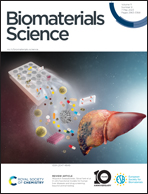Understanding and optimising the transfection of lipopolyplexes formulated in saline: the effects of peptide and serum†
Abstract
Lipopolyplexes (LPDs) are of considerable interest for use as gene delivery vehicles. Here LPDs have been prepared from cationic vesicles (composed of a 1 : 1 molar ratio of DOTMA with the neutral helper lipid, DOPE), singly branched cationic peptides and plasmid DNA. All peptides contained a linker sequence (cleaved by endosomal furin) attached to a targeting sequence selected to bind human airway epithelial cells and mediate gene delivery. The current study investigates the effects of novel Arg-containing cationic peptide sequences on the biophysical and transfection properties of LPDs. Mixed His/Arg cationic peptides were of particular interest, as these sequences have not been previously used in LPD formulations. Lengthening the number of cationic residues in a homopolymer from 6 to 12 in each branch reduced transfection using LPDs, most likely due to increased DNA compaction hindering the release of pDNA within the target cell. Furthermore, LPDs containing mixed Arg-containing peptides, particularly an alternating Arg/His sequence exhibited an increase in transfection, probably because of their optimal ability to complex and subsequently release pDNA. To confer stability in serum, LPDs were prepared in 0.12 M sodium chloride solution (as opposed to the more commonly used water) yielding multilamellar LPDs with very high levels of size reproducibility and DNA protection, especially when compared to the (unilamellar) LPDs formed in water. Significantly for the clinical applications of the LPDs, those prepared in the presence of sodium chloride retained high levels of transfection in the presence of media supplemented with fetal bovine serum. This work therefore represents a significant advance for the optimisation of LPD formulation for gene delivery, under physiologically relevant conditions, in vivo.

- This article is part of the themed collection: Celebrating the 200th Anniversary of the University of Manchester


 Please wait while we load your content...
Please wait while we load your content...